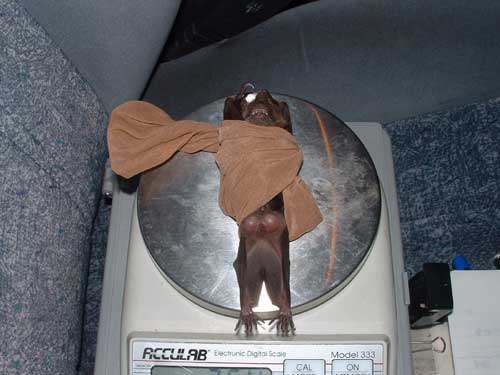Guide to the bats of Montserrat
Artibeus jamaicensis Chiroderma improvisum Brachyphylla cavernarum Noctilio leporinus Ardops nichollsi Sturnira thomasi Monophyllus plethodon Molossus molossus Tadarida brasiliensis Natalus stramineus Key to Roosts Key to Taxa
(Photo A. Hartpence)
Male getting weighed
(Photo A. Hartpence)
Jamaican Fruit Bat - Artibeus jamaicensis
STATUS: These bats are distributed widely throughout most of the Caribbean.
IDENTIFICATION: Leaf-nosed bats are large bats having a wingspan of up to about 40-45 cm. The snout ends in a noseleaf, which is an interesting flap of skin, muscle, and cartilage that assists the bat during echolocation. Whereas mainland species of Artibeus often have very dramatic 'eye-stripes', Artibeus that live in the northern Lesser Antilles have only faintwhite stripes of fur above and below the eyes. The fur is of medium length and is quite thick. A relatively narrow band of skin is stretched along the inner surface of the back legs (tail membrane) that assists the bat during flight. Leaf-nosed fruit bats are also similar in appearance to the smaller 'Tree bat' (Ardops) which has white tufts of fur on its shoulders.
ROOSTS: Unlike the much larger Pig-nosed bats (Brachyphylla), Jamaican fruit bats roost quietly during the day, and typically hang individually or in small clusters in a very wide range of structures, including caves, rock overhangs, rock fissures, hollow trees, foliage, and even man-made structures such as buildings.
DIET: Jamaican fruit bats have been observed to eat pollen, nectar, fruit, and insects though they are most commonly associated with large cultivated and wild fruits (Mango, Papaya, but not citrus fruits). These bats will form flocks and will mob rich feeding sources like fruiting trees. Often they will carry fruit in their mouth back to a nightroost and eat it there. If these fruits are dropped accidentally, the seeds may germinate an start a new tree. Their droppings vary in size and appearance depending on what they have been eating - dark brown-black, and sticky after a fruit meal, or coarse/crumbly with glistening specks of insect exoskeleton after eating insects. Leaves are sometimes chewed (presumably to extract fluid) then spat out as small dry pellets of leaf fibers onto the roost floor. Because roosts used by these bats are often fairly well lit, seeds dropped onto the floor may germinate. These bats may have some minor impact on cultivated fruit production, but are also important seed dispersers and pollinators of these same crops. Artibeus will often feed throughout the night, except on brightly moonlit nights when they avoid flying - "lunar phobia" - a strategy for avoiding predators.
REPRODUCTION: This species may produce two pups per year if the conditions are good. Pregnant females have been found during February and July, while nursing mothers have been found April-July and as late as September. Births are timed to coincide with the rains/times when the greatest amount of food (flowers or fruit) is available. Babies are weaned at around two months, but will attempt their first flights at 5-6 weeks of age. Artibeus will form harems in which a single male bat will defend 3-5 females.
SIZE: Measurements: Forearm length - 61mm [range 55-70mm]; Mass - 46g [range 31-49g]; Wingspan - approx. 430 mm; Head+body length - 75-85mm.
COMMENTS: Several common names have been applied to this animal, including: Common fruit bat, Jamaican fig-eating bat.
REFERENCE: Demography and natural history of the Common fruit bat, Artibeus jamaicensis, on Barro Colorado, edited by C. O. Handley Jr., D. E. Wilson & A. L. Gardener. Smithsonian Contributions to Zoology No. 511: pp i-iii + 1-173 (1991).
See Entry: Walker's Mammals of the World Online version 5.1, by Ronald Nowak, 1997


